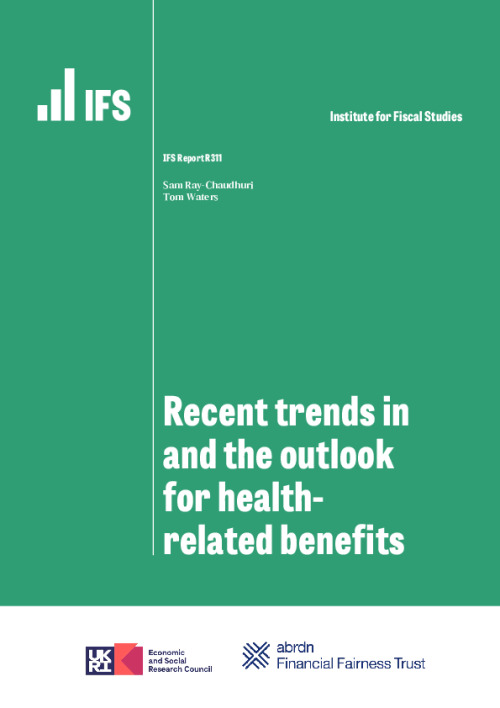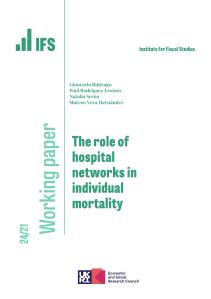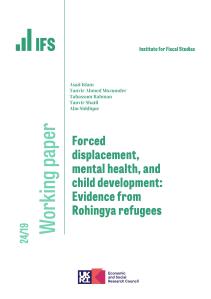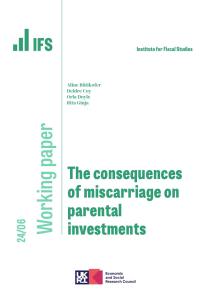The authors gratefully acknowledge the support of the abrdn Financial Fairness Trust (202309-GR000090) and the ESRC Centre for the Microeconomic Analysis of Public Policy (ES/T014334/1).
Executive summary
Individuals in the UK with health conditions may be entitled to two types of benefits – incapacity benefits (for those whose condition prevents them from working) and disability benefits (to help with extra living costs arising from the disability). Since the onset of the pandemic, there has been a substantial increase in the number of individuals claiming these ‘health-related’ benefits – and official projections suggest that claimant numbers will rise further still. Whoever wins the next election will have to come to terms with these trends and potentially provide a policy response. Indeed, the government has already announced a number of reforms to the health-related benefit system in the last year, including a consultation – announced by the Prime Minister in April 2024 – on tightening the disability benefit system. This report sets out the latest data on health-related benefits in the UK and discusses the evidence on potential causes for the rise, before considering the policy options.
Key findings
1. There are now 4.2 million working-age individuals (10.2% of the working-age population) receiving at least one health-related benefit. This is up from 3.2 million in 2019 (7.9%). The rise is driven by rapid increases in the number of people starting a new benefit claim. Prior to the pandemic, both incapacity and disability benefits saw about 20,000 new claims each month. By November 2022, there were 51,000 new claims for incapacity benefits and 43,000 new claims for disability benefits each month.
2. Calculations using forecasts from the Office for Budget Responsibility and the Scottish Fiscal Commission suggest that, by 2028–29, the health-related benefit caseload will have risen by another 1.2 million to 5.4 million (12.4% of all working-age individuals). This is based on a judgement that the rates of flow onto these benefits will fall back from their current high levels. If the pace of recent new claims persisted, we estimate that the number of claimants in 2028–29 would be 1.6 million higher than now (5.8 million). Conversely, if the rates of flow onto these benefits returned to their pre-pandemic levels, the increase would be just 200,000 (to 4.4 million).
3. As a result of these increases in caseloads, spending on disability benefits and incapacity benefits for working-age individuals rose by £12.8 billion between 2019–20 and 2023–24 (£35.6 billion to £48.3 billion) – including the standard universal credit allowance for those with health conditions. It is set to increase by a further £15.4 billion by 2028–29 (all in 2024–25 prices). This will take total health-related benefit expenditure on working-age individuals to £63.7 billion per year. These are substantial figures: total expenditure on all working-age benefits in 2028–29 is forecast to be £144 billion.
4. It is now the case that around 1 in 6 people aged 60–64 receive incapacity and/or disability benefits. However, increases since 2019 have been fastest in proportional terms for younger people. The share of 25-year-olds on these benefits has risen from 4.9% to 7.0% and the share of 55-year-olds from 11.4% to 13.4%. As a result of these increases, a 20-year-old today is about as likely to claim a health-related benefit as a 39-year-old was in 2019; a 35-year-old today is about as likely to claim as a 46-year-old in 2019; and a 55-year-old today is about as likely to claim as a 60-year-old in 2019.
5. Mental & behavioural disorders and musculoskeletal diseases are the primary types of condition, associated with nearly two-thirds of recent disability benefit awards. Mental & behavioural disorders alone accounted for 41%, up from 32% prior to the pandemic. These conditions are the most common among those applying for incapacity benefits as well. The conditions that claimants have are strongly related to age: 69% of new 25-year-old disability benefit claimants were primarily living with mental & behavioural disorders, while this was the case for only 22% of new 55-year-old claimants.
6. The causes of this worrying trend are yet to be fully understood. There is evidence that health is worsening among the population. But other possible – and as yet unconfirmed – hypotheses include the cost-of-living crisis, conditionality regimes and the shift towards telephone assessments.
7. Given the lack of clarity on the underlying cause, there are no obvious solutions to this growing problem. Tightening eligibility rules could get the caseload numbers down, but past reforms in this vein have often had less effect than anticipated. Straightforward cuts to the cash value of benefits would certainly save money but would create real difficulties for a significant fraction of the population. The government has outlined a number of reforms, which if implemented could result in fundamental changes to the system.
1. What support is there in the UK for people with health conditions?
The UK benefits system has a number of benefits targeted at individuals living with health conditions or disabilities. The age of an individual and the nature of their condition jointly determine the type and level of support available.
For individuals of working age, there are two types of health-related benefits, often described as incapacity benefits and disability benefits. These have separate eligibility criteria and application processes, but individuals can apply for both. Incapacity benefits are based on assessment of a person’s capacity for work and are predominantly means-tested – meaning an individual must be part of a family with low income to receive them.1 A new claimant to incapacity benefits would receive the support as the ‘limited capability for work element’ in their universal credit (UC), although there are still a large number of individuals receiving older incapacity benefits.2 Individuals are assigned to one of two groups depending on the severity of their incapacity. Those in the more severe group receive an additional £416.19 per month on top of their standard UC allowance and are exempted from any job search or preparation requirements. Those in the less severe group do not receive any additional income and may be required to prepare for work (e.g. by preparing a CV), but are exempted from requirements to search for a job that are faced by an unemployed individual not judged to have a limited capability for work.
Personal independence payment (PIP) is the main disability benefit for individuals of working age. PIP is not means-tested and is intended to compensate individuals for higher disability-associated living costs.3 In contrast to incapacity benefits, eligibility for disability benefits is not directly linked to an individual’s income or ability to work. Rather, it is determined by an individual’s assessed inability to carry out certain tasks (such as dress themselves or get around), which is deemed to generate additional living costs. PIP claimants are entitled to between £124 and £799 per month depending on the severity of their disability, comprised of ‘daily living’ and ‘mobility’ components. It is possible to get a higher or lower amount of each component, and to receive only one or both of the components. More than one-third get the maximum amount – the higher level of both components – and two-thirds get the higher amount for daily living and/or mobility. While claimants have an array of conditions at all levels of PIP, those getting the enhanced daily living component often have a mental health condition, while those getting the enhanced mobility component usually have a physical condition.4
In March 2023, the government published a health and disability White Paper, which proposed a number of reforms to health-related benefits (Department for Work and Pensions, 2023). This included a plan to scrap the assessment for incapacity benefits and instead determine eligibility for incapacity benefits using the PIP assessment (while retaining the means test). This would be a radical departure from the system described above, leaving no benefits explicitly targeted at people with limited ability to work. Because of the differing aims of the assessments (costs versus ability to work), the activities individuals are assessed on are different for PIP and incapacity benefits. For example, there is greater emphasis on mobility in the incapacity benefits assessment.
In this report, we primarily focus on claimants of working age, since this is the largest part of the system, and the group that accounts for the majority of the dramatic changes seen since the beginning of the pandemic. While children and pensioners cannot receive incapacity benefits, they are entitled to disability benefits. Children under 16 can apply for disability living allowance (DLA), which operates in a broadly similar way to PIP. Pensioners cannot make a new application for PIP, but can apply for attendance allowance if their disability is judged severe enough to require someone else to care for them.
2. How many people receive health-related benefits?
Since the beginning of the pandemic, there has been a stark change in the number of working-age people receiving health-related benefits. Figure 1 shows the numbers claiming incapacity benefits and disability benefits since 2002–03, including forecasts up to 2028–29 based on figures from the Office for Budget Responsibility (OBR) and the Scottish Fiscal Commission (SFC).5 For incapacity benefits, there has been a striking change in trend over the past few years. Between 2002–03 and 2019–20, the number of people receiving incapacity benefits fell by around 250,000, despite the rising female state pension age effectively expanding the pool of potentially eligible people over this period. In the four years since, the number of incapacity benefit claimants has grown by 700,000 to 3.2 million, far surpassing the fall seen during the preceding 17 years. Forecasts from the OBR indicate that the rate of increase is expected to remain high, leading to 3.8 million working-age individuals receiving incapacity benefits by 2028–29.
Turning to disability benefits, before the pandemic there had been a steady increase in the number of claimants, rising from around 1.5 million in 2002–03 to 2.3 million in 2019–20 (50,000 extra per year). The rate of increase has accelerated sharply since then however, growing by 1 million to 3.3 million between 2019–20 and 2023–24 (250,000 per year). The number of people claiming disability benefits is forecast to rise to 4.6 million by 2028–29, more than three times as high as in 2002–03 and twice as high as in 2019–20. The forecasts also suggest that the number of working-age people on disability benefits will grow much faster than the number of people on incapacity benefits over the coming years. This highlights one of the key risks associated with the proposed White Paper reform to replace the incapacity benefits assessment with the disability benefits assessment. It means basing the system entirely around the assessment that is growing fastest, and so could further accelerate increases in caseloads.
The increase since the pandemic and the further rises forecast are a result of rapid rises in the number of people beginning a claim. Figure 2 shows that the monthly numbers of new claims for incapacity benefits and disability benefits were broadly stable in the lead-up to the pandemic, both at around 20,000. There was a large spike in the number of new incapacity benefits claims shortly before the start of the pandemic; the exact reason for this is unclear but it may have been related to the roll-out of UC. When the pandemic hit, there were various temporary easements which saw the success rate of applications reaching almost 100%. There was also a (smaller) jump in the number of new disability benefit claims. Since then, both benefits have seen a steep rise in the number of new claims, such that by November 2022 the numbers were at least double the levels seen pre-pandemic – 51,000 for incapacity benefits and 43,000 for disability benefits.
Importantly, Figure 1 does not tell us how many people receive a health-related benefit, since one can claim both incapacity and disability benefits. This is the issue that we turn to now. Figure 3A shows the share of the population receiving either incapacity benefits, disability benefits or both, by age. Overall, 4.2 million working-age adults (10.2%) now get at least one of these benefits, up from 3.2 million (7.9%) in 2019. Using the disability and incapacity caseload forecasts discussed above, we calculate that this could be 5.4 million (12.4%) by 2028–29 (a rise of 1.2 million).6
The OBR and SFC’s forecast is for the numbers of new claims to slow from their current high levels, but to still be above pre-pandemic norms for some time. We can use the caseloads in Figure 1 to estimate what the numbers receiving a health-related benefit in 2028–29 might look like under alternative scenarios for inflows (new benefit claims beginning) and outflows (claims ending). If the rates of inflow and outflow immediately returned to their pre-pandemic levels from 2024–25 onwards, the caseload by 2028–29 would be 4.4 million (an increase of 200,000 rather than 1.2 million). If instead rates of inflow and outflow continued at the same rate as between 2022–23 and 2023–24, the caseload by 2028–29 would be 5.8 million (a 1.6 million increase). This is because rates of inflow are forecast to slow from their current levels, but remain far higher than they were pre-pandemic.
Unsurprisingly, there are significant differences by age. In 2023, 17% (around 1 in 6) of those aged between 60 and 64 received disability and/or incapacity benefits, compared with 7% (around 1 in 15) of those aged between 16 and 24. There are also differences in the type of benefits that individuals of different ages are receiving.7 Broadly, as you go up the age spectrum, the rise in health-related benefits is mostly accounted for by more people getting both incapacity and disability benefits. The contribution of ‘incapacity benefits only’ is somewhat smaller among older ages, consistent with older individuals being more likely to have savings or a working partner that makes them ineligible for incapacity benefits (but not for disability benefits, which are not means-tested).
Figure 3B plots the share of individuals receiving any health-related benefit by age, with the August 2023 line being equivalent to the total area of the chart in Panel A. Between 2019 and 2023, there has been a broadly consistent increase of roughly 2 percentage points seen at all ages. This implies differing proportional changes though, because the share of older individuals receiving a health-related benefit was much higher initially. For example, the share of 55-year-olds has risen by 2.0 percentage points from 11.4% to 13.4%, equivalent to a proportional rise of 18%. The share of 25-year-olds has risen by a similar 2.1 percentage points, but from 4.9% to 7.0% ¬– a proportional rise of 44%. These changes mean that a 20-year-old today is about as likely to claim a health-related benefit as a 39-year-old was in 2019; a 35-year-old today is about as likely to claim as a 46-year-old in 2019; and a 55-year-old is about as likely to claim as a 60-year-old in 2019. For older adults aged between 35 and 60 (those unaffected by changes to the female state pension age), the change since 2013 is smaller than the change since 2019, because there was a decline in the share receiving health-related benefits between 2013 and 2019. The recent rise has more than offset this decline across the board.
3. What has happened to health-related benefits expenditure?
Recent changes in the caseloads for incapacity benefits and disability benefits have significant implications for spending. Figure 4 shows benefit expenditure aimed at people with health conditions over time, split by age group. 74% of spending is currently directed towards individuals of working age, with 20% going to pensioners and 6% going to children.
For those of working age, the average spending on disability benefits and incapacity benefits (including the standard UC allowance for those deemed to have ‘limited capability for work’) per claimant remained stable between 2019–20 and 2023–24, at around £7,400. This could be attenuated by a shift from employment and support allowance to UC, where the support for incapacity differs significantly (with winners and losers). Therefore, the 36% rise in caseload (see Figure 1) translates into a 36% rise in spending (£12.8 billion, to £48.3 billion). In percentage terms, growth in spending on children was larger, rising by 47% between 2019–20 and 2023–24 (£1.3 billion). Over the same period, spending on pensioners has not changed significantly (up by £0.1 billion).
Figure 4 also shows the combined OBR and SFC forecasts for spending until 2028–29. In line with the continued rises forecast for working-age caseloads, large real-terms increases in spending are projected to continue until the end of the forecast period. This would take total spending to £86 billion (a 67% rise since 2019–20), and spending on individuals of working age to £64 billion (a 79% rise). This is a much faster rate of increase than seen for all working-age benefit expenditure (including incapacity and disability benefits), which is projected to grow in real terms by £30 billion between 2019–20 and 2028–29 (£114 billion to £144 billion, a 27% rise).
4. What types of conditions do people receive health-related benefits for?
We now examine the conditions that claimants have. Figure 5 shows the distribution of primary conditions associated with successful PIP applications for two distinct periods, one using recent data (January 2022 to November 2023) and one based on pre-pandemic data (January 2018 to November 2019). Note that, in order to focus on the post-pandemic rise in PIP, these data relate to new PIP claimants (as in Figure 2) rather than the entire caseload. Two types of condition – mental & behavioural disorders and musculoskeletal diseases – accounted for the majority of PIP awards during both periods. Diseases of the nervous system and cancers are the two next most common conditions.8 The most significant change in conditions seen between the latest data and the pre-pandemic period is the rise in the share of mental & behavioural disorders, recently accounting for 41% of new PIP claims compared with 32% before the pandemic. The conditions that PIP claimants have is strongly related to age. In the post-pandemic period, 69% of new claimants aged 25 had a primary condition listed under mental & behavioural disorders. This was the case for only 22% of new claimants aged 55.
The data for the health conditions of incapacity benefit recipients are slightly different. Whereas in the PIP data a primary condition is recorded, the data for the incapacity benefits assessment (Work Capability Assessment) records multiple conditions per claimant, without one being listed as primary (on average, a successful claimant has 3.4 conditions). In addition, while we have data for the health conditions of new UC-health claimants for January 2022 to November 2023, we do not have a pre-pandemic data point. Nonetheless, we still see a broadly similar picture to that for PIP. As Figure A1 in the appendix shows, mental & behavioural conditions and musculoskeletal diseases are by far the most important, accounting for 44% of all conditions recorded. In fact, 91% of recent assessments have recorded a mental or behavioural condition (noting that in many cases there will be other conditions too, and the mental condition may not be the primary one).9
5. What might be driving the recent rise in health-related benefits?
Substantial increases in the numbers receiving health-related benefits pose significant challenges to policymakers who must either find cash to fund them or propose reforms to ease the burden. Coming up with sensible reform ideas is greatly helped by an understanding of the factors driving this trend. While there is no strong case to be made for a single cause, in this section we highlight some of the existing evidence on worsening health, falling real incomes, conditionality regimes and assessment outcomes.
Certain indicators suggest that worsening health among the population may be one reason for the rising share of people receiving incapacity or disability benefits. Joyce, Ray-Chaudhuri and Waters (2022) find that the proportion of applicants awarded PIP at assessment has remained roughly the same since 2016, meaning that higher onflows were a result of increased applications (rather than a more lenient system allowing more people on). This is consistent with a worsening in the health of the population, a hypothesis supported by survey data which show increases in the number of working-age individuals reporting that their health limits their daily activities. Analysing what might have led to this decline in health outcomes is beyond the scope of this report, although the COVID-19 pandemic and the resultant spike in NHS waiting lists have both been suggested as potential causes.
Falling real household incomes since the start of the pandemic may also have induced greater numbers of individuals to apply for health-related benefits. In its November 2023 forecast, the OBR revised down its forecast for the growth in caseloads, believing that improvements in economic conditions would reduce the numbers applying (Office for Budget Responsibility, 2023b). Applications for health-related benefits can be onerous, requiring individuals to assemble evidence on their condition and undergo assessments. As a result, they may only submit one if they believe the additional income they could receive is worth more than the hassle associated with applying. Falling real incomes caused by high inflation over recent years might mean higher value is placed on additional income, inducing more people to apply for health-related benefits. In line with this sort of effect, Maestas, Mullen and Strand (2015) find that applications for disability insurance in the United States rose during the Great Recession, although almost all of the additional applications induced were denied at the first stage – unlike what we have seen in the UK since the beginning of the pandemic. Examining an earlier period in the US, Black, Daniel and Sanders (2002) find that better local labour market opportunities lower participation in disability programmes. If this relationship holds for the UK, then we might expect to see onflows to health-related benefits slow as cost-of-living pressures ease.
Another possibility is ‘job search conditionality’. An individual claiming UC, out of work but not judged to have limited capability for work, is usually required to look for a job. If they fail to do so without good reason then they may be sanctioned, meaning their UC payments are reduced. Individuals receiving incapacity benefits are exempted from some or all conditionality requirements. Therefore, if the conditionality regime becomes more demanding, that increases the incentive to apply for incapacity benefits. Codreanu and Waters (2023) find that following the expansion of conditionality to lone parents between 2008 and 2012, for every four individuals who moved into work in response to the policy, another three started claiming incapacity benefits. UC sanction rates have more than doubled since before the pandemic (Department for Work and Pensions, 2024c). However, it is not clear whether this represents a genuine increase in the ‘toughness’ of the conditionality regime or a change in the composition of the UC caseload since the beginning of the pandemic towards groups that may be more likely to be sanctioned. As things stand, this seems like a plausible but far from confirmed hypothesis.
There have also been changes in the assessments for incapacity and disability benefits that might explain increasing numbers of people claiming. Prior to the pandemic, claimants were generally assessed face-to-face. The onset of the pandemic led to the suspension of face-to-face assessments, with applicants instead being assessed via telephone or video call, and this has largely persisted since.10 There is limited evidence on what effect this may have had, but it is possible that some individuals may have decided to apply in the knowledge that they would not be subjected to a potentially stressful face-to-face assessment.
The success rate of applications, meaning the share of applicants who are judged eligible for incapacity and disability benefits after assessment, also affects the rate of increase in benefit caseloads and expenditure. Even holding the number of applications constant, an increase in the success rate would mean higher numbers of individuals flowing on. As mentioned above, Joyce, Ray-Chaudhuri and Waters (2022) found that the PIP success rate was roughly the same after the pandemic as it was before. For incapacity benefits, between April 2020 and March 2021, the share of individuals assessed as having limited capability jumped up to more than 95% (Department for Work and Pensions, 2024b). But the success rates in the year before and in the period since were similar at around 83%. Taken together, this suggests that increased numbers of applications have been a more important factor than greater leniency.
6. What are the policy options for the next government?
The rise in the number of individuals claiming incapacity and disability benefits is a worrying trend, lacking an obvious explanation. More than four years on from the beginning of the pandemic, the idea that this might be a transitory bump in applications prompted by exceptional circumstances during the pandemic looks increasingly unlikely. The direct fiscal implications are large, with spending now forecast to grow by two-thirds during the 2020s. Moreover, recipients of these benefits are often out of the labour force, so the rise could also be contributing towards increased labour market inactivity.11 Some form of policy response appears increasingly likely as time goes on, though finding the right reform is obviously made much harder given that the underlying cause is not clear. In this section, we outline some of the ways a future government could try to ease the pressure. Clearly, improving the population’s health would be a highly attractive way to reduce benefit claims. But needless to say, this is far easier said than done, any such improvement would surely involve substantial spending commitments and returns may take time to materialise. We therefore restrict ourselves to reforms to the welfare system itself.
One option for the government is to toughen the eligibility criteria for incapacity and disability benefits, in order to restrict the number of people qualifying. This has already been proposed for the Work Capability Assessment for incapacity benefits, on the basis that the expansion of remote working makes it easier for sick individuals to find employment. In principle, something similar could also be done for disability benefits, although arguably with less justification since disability benefits are not linked to capacity for work. This type of reform can require time to take effect, as new assessments are usually rolled out to new claims initially before being expanded to existing recipients. Results, in the form of reduced caseloads, are not guaranteed either. The introduction of PIP was expected to reduce disability benefits expenditure and caseload – in fact, spending increased more quickly after the roll-out than it had done before (Cribb, Karjalainen and Waters, 2022).
Cutting the amounts paid to benefits recipients would be an operationally more straightforward way of reducing the bill, which would avoid much of the uncertainty associated with reformed assessments. Of course, since many people on health-related benefits rely on those benefits for much of their income, cuts would imply significant falls in living standards. Cribb, Karjalainen and Waters (2022) show that people on disability benefits are much less likely to be employed and much more likely to be in poverty and material deprivation than working-age adults in general. Making up the shortfall from any cuts could be extremely challenging for some claimants whose condition prevents them from working.
Another option is to undertake more fundamental reform, altering the structure of the system. In March 2023, the government published a health and disability White Paper, which outlined a large number of reforms to health-related benefits (Department for Work and Pensions, 2023). Among these was a plan to change eligibility for incapacity benefits, basing it on the PIP assessment for disability benefits instead of a separate Work Capability Assessment. This was designed to remove barriers to work for those receiving incapacity benefits and simplify the system by moving to a single assessment. These are commendable aims, although whether the changes would produce any significant employment response is hard to predict, and the reform would reduce entitlements among certain groups whose conditions increase their living costs but do not significantly impinge upon their capacity for work. Ray-Chaudhuri and Waters (2023) find that, before any change in behaviour, roughly 300,000 would see their benefit entitlements rise and roughly 500,000 would see them fall. The future of these proposals will depend on the outcome at this year’s general election, but this serves as an example of the difficulty associated with policymaking in this area.
The government has also just announced a consultation on tightening the disability benefits system. The Prime Minister's speech announcing the consultation refers to potentially radical changes to the PIP system, particularly surrounding how individuals living with mental health conditions are treated compared with those with physical health conditions. This could bend down the expenditure curve, though in previous reforms of this nature the anticipated savings have sometimes not materialised.
The remarkable rise in incapacity and disability benefits claims since the beginning of the pandemic has been one of the most notable trends, not only in benefits policy, but across all areas of government spending. There has been an increase in the share of the population who receive a health-related benefit spanning all age groups, with the biggest rises seen among younger individuals. Mental health conditions now account for an even greater proportion of new cases than previously. There are steps that a government could take to try to stem the flow, although none would be easy. Nevertheless, given the difficult fiscal position that the next government will be presented with, this is an issue it will find hard to ignore for long.












